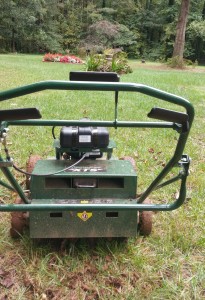

Fescue Aeration and Overseeding
If you have Fescue Grass then you may or may not know that Fall is an ideal time of year to Aerate and Overseed your fescue lawn to repair damaged areas from the stress of the summer. Fescue grass is one of the more easier turf types to establish from seed which does quite well in partially shaded areas where warm season turf may not do so well. Fescue seed will germinate when the soil temperatures are between 50 and 65 degrees, which means the air temperatures should roughly be between 60 and 75 degrees. This is why fall is an ideal time to preform the fescue aeration and overseeding service.
Prepping Your Lawn for Aeration and Overseeding
Fescue Seed will tend to germinate within a time frame of 10 to 14 days when properly planted and cared for. There are a few steps you should take before the aeration process is performed…
1. Mowing – It is recommended that you mow your lawn a little shorter than normal. This will help ensure that the aeration and seeding is more effective, as well as buy you some time on having to mow the grass before the new seed comes up.
2. Remove Leaves and Any debris
3. Mark Sprinkler Heads – If you have an automatic sprinkler system than it is imperative that you clearly mark any of your sprinkler heads before your lawn is aerated. This will prevent any damage to your sprinkler heads that could be caused by aeration equipment.
3. Water the Lawn – It is extremely important to thoroughly water the lawn for a few days before the aeration and overseeding is performed on your lawn. Softening the ground with a thorough watering will ensure good plugs are pulled and will give optimal chance for good seed to soil contact.
Core Aeration Vs. Spike Aeration
Aeration is one of the first steps in the process. Using the right equipment to get the job does is important to optimize results from Aeration and overseeding. Core aeration is the preferred method. Spike type of aerators are not recommended because they just push the soil down and can cause more compaction. A good core aeration is the way to go to break up soil compaction and improve water and airflow. Sharplawns Turf Care, LLC uses state of the art well maintained core aerators to get the job done properly.
Which Seed should i use
You want to go with a certified and tested seed blend that has good disease and drought resistance. Sharplawns Turf Care uses a blue tag certified and tested triple blend turf type tall fescue seed that does excellent in partially shaded areas.
Straw or No Straw?
Wheat can be used sparingly in bare areas that may be prone to dry out quicker. This can help hold in moisture better. However, keep in mind that wheat straw will tend to germinate later on along with the fescue and become more of a “weed” problem in your new lawn.
Watering to maximize germination
Proper watering is important for best germination results. We recommend watering the lawn twice a day for the first 10 to 14 days for best results. You want to keep the seed bed damp by lightly watering 2 times per day. Avoid drenching or overwatering. To much water on your new seed can cause the seed to rot and to little water and the seed can dry out. Once most of the seed has germinated you can then cut back on your watering to a more normal watering schedule, you should expect to get to that point in 3 to 4 weeks.
Mowing your New Lawn
Your new grass is ready to mow when it reaches about 4 inches. You want to be sure to not mow when the lawn is wet. Its a good idea to bag the lawn each cut until the grass has matured. Clippings mulched back on the lawn could potentially damage your new lawn so use caution when mowing.
Comments are Disabled